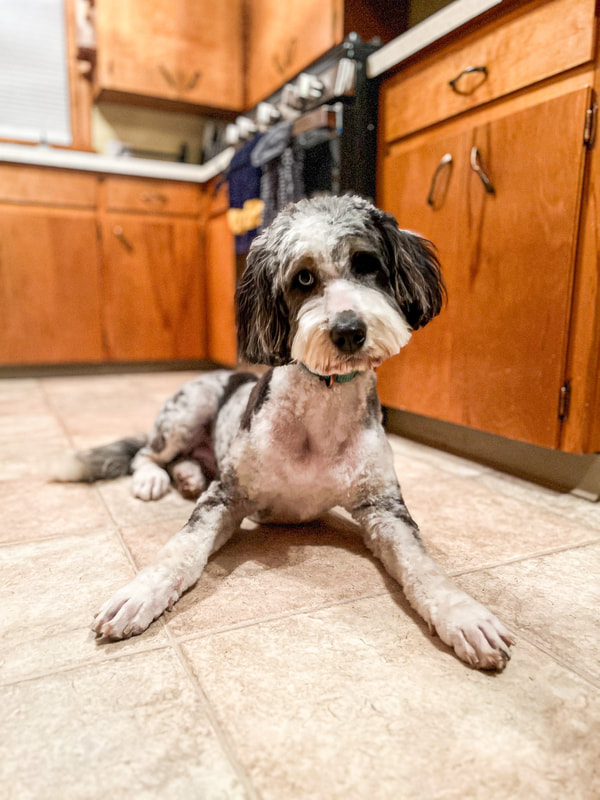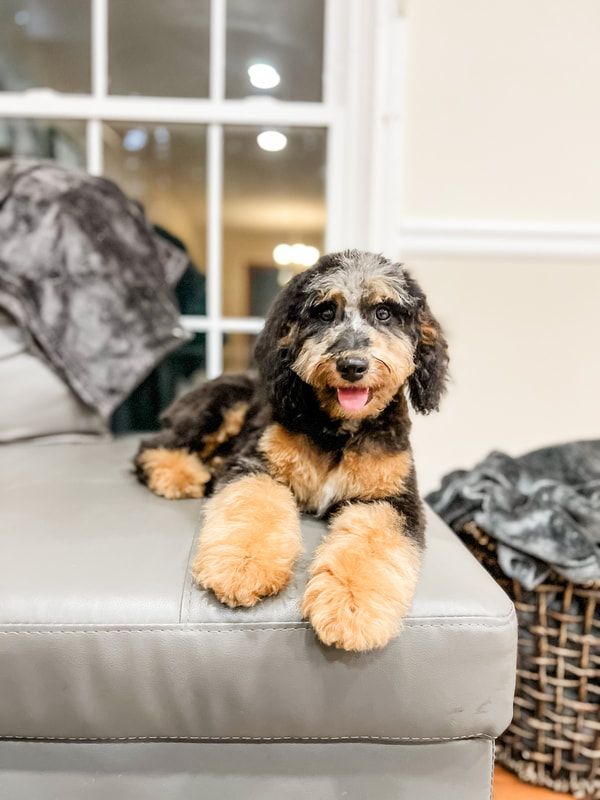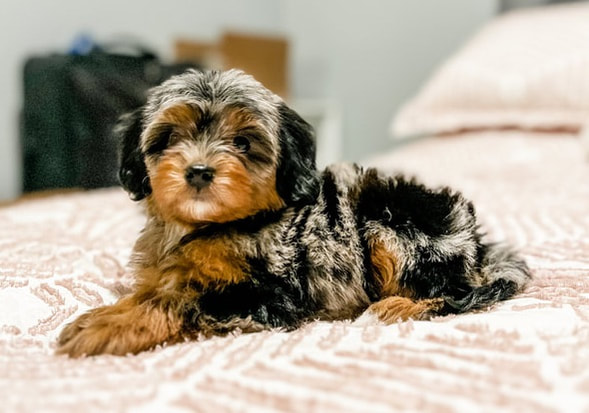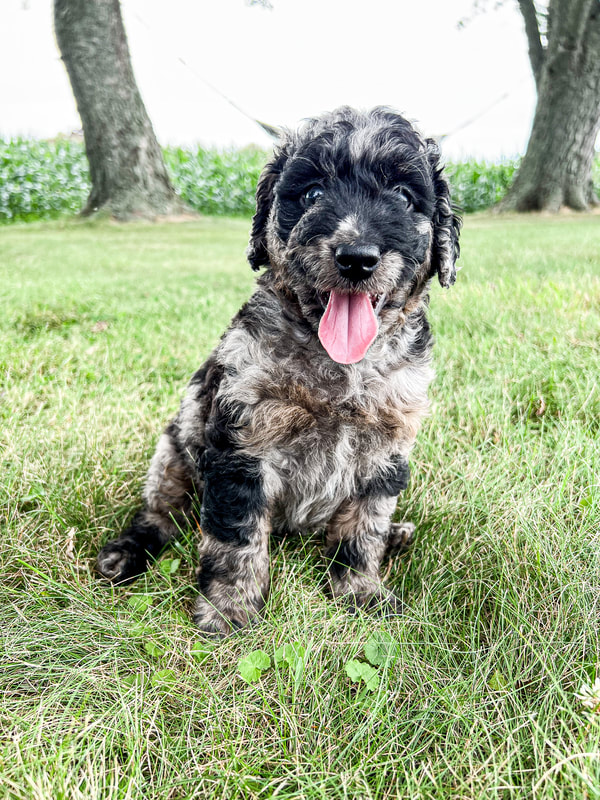|
When helping potential families figure out which breed of doodle puppy or waitlist they are interested in, this is probably the most common question I get: "Is the Aussiedoodle or the Bernedoodle the right breed for me?" So, I figured why not write an article about the differences (pros & cons) between the Aussiedoodle and the Bernedoodle. I have been breeding Aussiedoodles for 6 years and Bernedoodles for 4 years, and I have learned first hand the differences between the two breeds. They are quite similar, but they do have a few differences that are pretty distinct.
I will preface this article with clarifying that all of the differences below depend greatly on the parents of the puppies. We focus our program on low energy/low drive Aussiedoodles and Australian Shepherds as well as calm and relaxed Bernese Mountain Dogs/Bernedoodles. There are definitely very high drive/energy Australian Shepherd and crazy Bernese lines out there, we try to avoid those at all costs to ensure our puppies are balanced, friendly, family dogs. The differences below will be compared from a perspective of breeding these two breeds with intentionality and not just throwing two dogs together. So, with this being said, let's get into the differences. Let's start with the Aussiedoodle. The Aussiedoodle is a wonderful family dog, super friendly, always ready for the next family adventure, but also happy to just chill and relax with the family at home. I have found that the smaller sized Aussiedoodles (Toy & Mini) seem to have a slightly higher energy level than their Standard sized counterparts, but it is not overly excessive. The Aussiedoodles require about the same amount of physical exercise as the Bernedoodle (about 1-2 walks/play sessions per day), but where they vary greatly is in their brain power. The Aussiedoodles are EXTREMELY smart and require mental exercise such as learning new tricks, a job (picking up their toys & putting them back in the basket, etc), treat/kibble puzzles (these help to work their brain in order to get a treat or food), agility courses and things of this nature. Separation anxiety can be a problem (with both breeds), but with any dog, it is important to get them used to their crate. I notice the most problems with puppies who are home all day with a "work from home" parent and are able to be beside them all day long. In this case, it is extremely crucial that you work on crate training each day, even when working from home. Put the puppy in a room or place that is out of sight from you as you work. This will get them used to being ok with not being around you all the time & is a great tool to help house train the puppy as well. The Aussiedoodles are known to be "velcro dogs", you won't do much alone if it's up to them, you will often have a visitor in the bathroom, in the kitchen, or at the desk. They usually have one family member they attach to most, but they definitely prefer to be by their humans rather than alone by themselves. The other thing I have noticed with Aussiedoodles is that they tend to have a higher chance of aggression, I find this usually stems from them not having a strong "leader". Dogs are created to need and respect a pack leader, if you are not strict enough with your training, your dog will learn that and begin to rule you, which can lead to aggression. I know this sounds crazy, but I have seen it first hand, good news is that it can be corrected with working with a trainer. Lastly, the Aussiedoodles are indeed from a working breed line and they can have tendencies to show herding/nipping characteristics, more commonly to younger children. It is important to let the puppies know that this is not ok, they are not doing it out of aggression, but out of their natural instinct. This characteristic tends to be less noticeable as you get more poodle into the mix (f1b, f2b, multigen, etc). The Bernedoodle is also a great family dog, great with kids, a little lower energy (than the Aussiedoodle), and always happy to be apart of the family excursions. They are a little more difficult to house train, and can be more timid in nature rather than outgoing. They rarely have a mean bone in their body and do very well with young children, they are very gentle and loving. They do great with putting up with young kids pulling on their hair/ears/etc. and not reacting in aggression. They aren't quite as velcro as the Aussiedoodle, but they definitely prefer to be around their humans rather than alone by themselves. Crate training is important with the Bernedoodle as well and is also an excellent tool in helping house train the puppy. I have noticed Bernedoodles have a higher chance of digestive issues and often times have to be on specific diets to ensure they have consistent solid stool. Bernedoodles are also notorious for chewing up (& eating) toys/objects that are not meant to be eaten. The Aussiedoodles can do this as well, but the Bernedoodles have seemed to win this award and I have to be very careful with the things I leave out when I am not watching them. Overall, both breeds (when bred well) are great family dogs. With proper training, both breeds are EXCELLENT options. I personally would put the Aussiedoodle slightly above the Bernedoodle if I had to pick, but that is just my personal preference. The Aussiedoodles have such a fun personality and are incredibly smart! As far as coloring, with the numerous colors of poodles now, you can get both breeds in the same colors. I hope this post was helpful to you as you try to figure out which breed of doodle best fits your lifestyle! As always, don't hesitate to reach out to us via Social Media (linked below) or text (330-347-4651) with any questions! -Riley & all of us at Steindoodles🐾❤️
0 Comments
You've begun your search for a new doodle puppy. There's so many options of doodles, so many breeders to choose from and just so many puppies. How do you possibly know where to begin? I am sure there is someone out there still trying to figure out what size doodle they are wanting. Do you want a Mini Aussiedoodle or a Toy Aussiedoodle? And what is the difference in size between a Mini Aussiedoodle and a Toy Aussiedoodle? What about the Bernedoodles? Each breeder has their own size ranges (especially when it comes to doodles) and its important to look into those sizes so you know what you are looking at. A mini bernedoodle will most likely be a different adult weight than a mini aussiedoodle and like wise a toy aussiedoodle will most likely be a different size than a toy bernedoodle. In general the aussiedoodle sizes run slightly smaller in height and weight than the bernedoodle sizes (but like I said each doodle breeder has different opinions on what they categorize into what size).
Ok... lets get onto the differences in sizes and a few things to think about. From my personal experience as a breeder, especially in the aussiedoodles, the smaller you get the more energy the dogs get. I feel like (in general) large breed doodles are more times than not very gentle. They just know how to act around small children, occasionally they forget how big they are, but they are just more laid back. On the other hand... the toy and mini doodles are just a little more high strung. These are definitely not blanket statements, but something that I have seen more common that not as a breeder who's bred standards, minis and toys. A few other things to think about - When traveling with a doodle, especially on an aircraft, the toy. sized doodles win the award for being the easiest to travel with. Most airlines have a 20 lb. weight limit for the carry on pets, so a toy size (according to most breeders standards) would fit onto an aircraft for easy travel. If you are talking a toy bernedoodle puppy, they may still be a little borderline as far as making the 20 lb weight limit. As a aussiedoodle breeder and a bernedoodle breeder, the ease of traveling with a small dog is definitely becoming more of a hit as families realize they want to include their four legged friends on their vacations and trips. The downsize of a small dog is that they are more likely to fall prey to a hawk, coyote, or a predator of some sort if not under constant supervision while outdoors. A larger sized doodle will more than likely be able to defend itself and escape the predator's plan. This is something that not everyone thinks about, especially if you live out in the country, where wild animals are more prone. Lastly, one other very important thing to think about is the cost to care for one of these doodle puppies. Obviously, the larger the dog, the more they will eat. But you will also have higher grooming costs, vet costs, and other various expenses that vary by size. Larger sized dogs obviously eat more, but at the groomer- most groomers charge each visit based on size in some form and when you are talking your doodles flea and tick medication most of those are larger doses for larger dogs and end up being more expensive in the end. Also - with spay and neutering, the anesthesia often costs more on larger dogs, bringing up the cost on the surgery. These expenses most likely aren't large differences, but they are definitely things to keep in mind and points to research to see just how much money you may save in your area by going with a smaller sized doodle or choosing a mini or even standard sized doodle. There are so many more things to think about when choosing the size of doodle that fits your lifestyle best, including weight limits in certain housing developments & apartments and the cost of the puppy (as smaller sizes tend to cost more). I hope this blog was helpful in some way as you consider the perfect doodle to add to your home. As always - if you have any questions or if you are in the market for a new aussiedoodle or bernedoodle, don't hesitate to reach out to me at 330-347-4651 or by email at [email protected]. Your looking for an Aussiedoodle (or any kind of doodle for that. matter) and you are getting confused by all the colors. What do all these colors even look like? I get it. It's complicated, and what makes it even more complicated is the fact that each breeder has their own reasons why they call a certain color the color they call it. Plenty of times, I see breeders listing puppies as colors they really aren't called. There are SO many color options in doodles and its definitely a learning curve and takes lots of dedication to learn the differences between each color. What complicates it more, is that lots of puppies look the same at birth, but as they get older - they change. With the Australian Shepherd already coming in a variety of colors itself, the Aussiedoodle is probably one of the only doodle breeds that comes in so many color options in its first generation. So... lets take a look at some of the most common colors that Aussiedoodles come in below! Blue MerleA true "Blue Merle", sometimes referred to as "Black Merle" (because of its black base color) has a mix of black, gray and sometimes white. The merle gene is a dilution gene, that dilutes the pigment on certain areas of the coat (causing the black to look a gray). A neat side note on the merles, merles have the highest chance of any color at having blue eyes, the reason for this is that if that dilution gene hits over the eye, it can dilute the eye pigment as well to the blue color (instead of brown, green, etc). Kind of neat, huh? What's even more intriguing is the fact that you can have a "marble colored eye" that is both blue and a different color (black, brown, green, etc) which gives the eye an almost "merle" color look as well when you look closely. Now - side note - there is also a blue eye gene in some breeds (for example: The Australian Shepherd) which can increase your chances at blue eyes but is not related at all to being Merle Colored.
The puppy pictured below has a Blue Merle Base (the black and gray colors) with a small patch of white on his front chest (often times classified as "Abstract") as well as a small hint of brown (which is considered "Phantom" markings). I'll dig into a few more of these markings below. You decide it's time to add a puppy to the family, but the process of finding the correct breeder looks daunting. Not only are there numerous breeds of Doodles, but there are hundred's of thousands of puppies available. And not even that, they range in price from a couple hundred bucks to well over $5,ooo a piece. Where do you even start? As a breeder, I feel this is a common question among all my potential families. As an experienced individual in the puppy breeding world I want to give my top 8 things to look for when you are searching for the best possible breeder.
1. Health & Genetic Testing: This is an essential. I don't care what the price of the puppy is or how it's been raised, if there has been no genetic testing of any sort completed on the parents that is the first red flag. Many health issues can be avoided by a simple genetic swab test showing pretty in depth results to decrease the chance of any common genetic issues showing up in the future. All the different tests that can be performed and more in depth detail on all that will be a post for a later date :) |
Archives
January 2024
Categories
All
|
© 2018-2024 by Steindoodles




